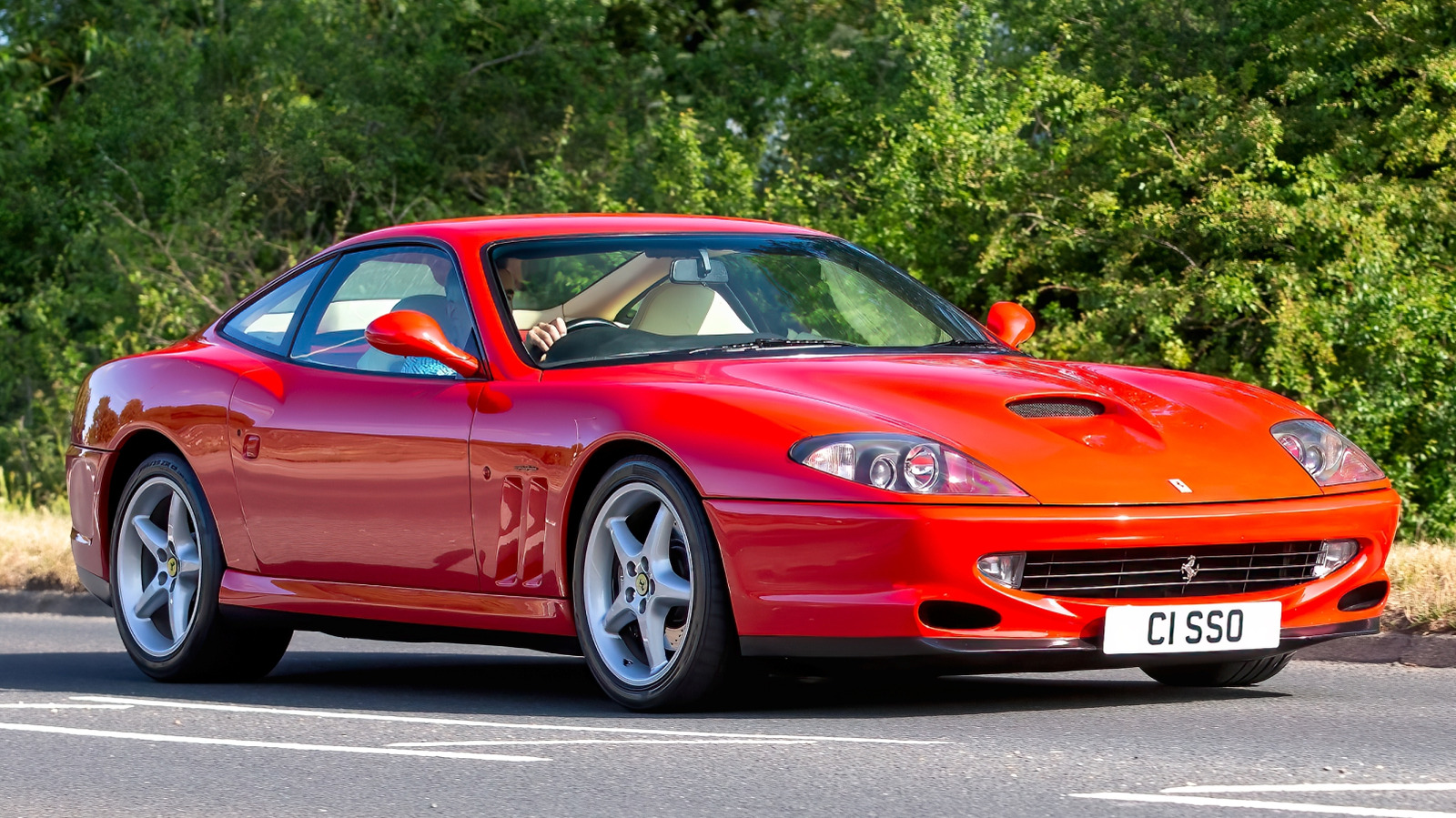
Before we get into those cars with impressively big gas tanks, it’s worth creating a frame of reference. On one side are the diminutive runabouts like the Mitsubishi Mirage and its 9.2-gallon tank. One of the most popular cars on the road, the Toyota Camry, comes in at just 13 gallons. And we’re only talking about production cars in sedan, coupe, wagon, and sports form: Step outside that definition, and you’ll find plenty of miniscule micro cars and gas tank behemoths like the GMT-400 Suburban, with its 42-gallon swimming pool of fuel, or the current Ford Super Duty lineup that offers an even larger 48-gallon reservoir. In this list, however, we aren’t considering crossovers, SUVs, and trucks.
Gas tank aficionados will notice the glaring lack of a C2 Corvette “Tanker” and its 36.5-gallon capacity from this list. That model didn’t make the cut because we’re considering only production vehicles, and those rare Corvettes were intended primarily for low-volume endurance racing. However, as you’ll soon learn, we don’t need fancy endurance racing vehicles to find a car with a big tank.
Though it has the smallest gas tank on this list, the now-discontinued Ford Taurus could hold almost 50% more fuel than the current Toyota Camry. With a highway fuel economy rating of 24 mpg, that translates to 456 miles of range. Enthusiasts should note that this gas tank size applies to the Super High Output Taurus, and not the standard model. This full-size sports sedan offered 365 horsepower and 350 lb-ft of torque from its 3.5-liter turbocharged V6.
Sport-tuned suspensions, summer tires from the factory, a 3.16 final drive ratio, and a 0-60 split of 5.2 seconds were all on tap. Granted, wide-open throttle runs would drain that big gas tank fairly quickly, but with the available heated and cooled front seats and moonroof, at least you’d be doing so comfortably. Once a U.S. sedan icon, the Taurus wrapped up North American production in 2019, after 34 years of continuous service.
A common thread in discussions about cars with big gas tanks is full-size luxury sedans, with all the major players being included on this list. Of those, the Genesis G90 has the smallest tank at 19.3 gallons. It also, arguably, has a lower brand cachet than rivals like the Mercedes S-Class and BMW 7-Series. However, smart shoppers know the G90 leans on its Hyundai value-oriented roots and comes packing serious style for the money. The distinctive styling with signature two-line headlights is pretty nice, too.
The 2024 Genesis G90 starts at $89,700, which is a significant $28,750 below the S-Class entry point. And yet, standard content includes a 375-horse twin-turbo V6, electronically-controlled suspension with “Road Preview,” a panoramic moonroof, power-closing doors, massaging front seats, and semi-autonomous driving tech. For serious luxury, you can add the air suspensions, which should keep you cruising in comfort over the 500 miles of driving range the G90 offers on the open road.
BMW has been producing its 7-Series flagship sedan for almost 50 years, and the latest G11-generation offers ample fuel capacity with space for 19.5 gallons. However, the prior F01 series, that ran from 2009 through 2015, offered a bigger one, at 20.6 gallons. One reason for this downsizing could be the improved fuel economy BMW has managed with the latest model, which squeezes out an extra two mpg on the highway. In either case, you’re looking at a range of about 600 miles.
To be clear, we’re talking about the base 7-Series with its 3.0-liter turbocharged inline-6 and “just” 320 hp. For 2017, BMW also offered a 4.4-liter turbocharged V8 powertrain, good for 445 hp, and a boosted 6.6L V12, making an eye-popping 600 horsepower. Depreciation is one reason to go for the older 7-Series and its bigger tank versus the more efficient newer models, but the real appeal is that available V12 lump. BMW no longer sells such an outrageous engine, and though it may not be as fuel-efficient as its six-cylinder stablemate, there’s no arguing with the V12’s cool factor.
Jaguar’s XJ had an incredible production run, stretching from 1968 through 2019, but its dramatic styling from the final generation, combined with the crossover onslaught, proved to be too much. Which is a pity as this fancy cat was a champ when it came to cruising in comfort. For one, you could easily crack 500 miles of highway driving range in the XJ, at least with the 340-hp supercharged V6 power plant. If performance is more your speed, a pair of supercharged V8 mills offered 470 or 575 hp, the latter of which could also run up to 174 mph.
These XJs had the same 21.1-gallon gas tank as V6 models, but were certainly not as fuel-efficient. However, this was more than made up for with top-end features like climate-controlled front and rear seats, an adaptive suspension, self-parking tech, swaths of real wood trim, and a Meridian audio system. For maximum passenger comfort, look to the long wheelbase XJ and its 44 inches of rear seat legroom, a 5-inch bump over the standard wheelbase variant.
Perhaps the most well-known of the big luxury sedan class, Mercedes-Benz has been refining its S-Class flagship for decades. The current generation, which has been on sale since 2021, cracks the 22-gallon gas tank barrier. With a 25-mpg highway fuel economy rating, you can cruise for more than 550 miles without a fill-up. That goes for the base S500 with its 3.0-liter turbocharged straight-6 making 429 hp, as well as for the more potent S580 that generates 496 hp and 516 lb-ft of torque from its twin-turbo V8.
Regardless of powertrain, all occupants should be quite comfortable on long commutes, given the 44 inches of back seat legroom and standard amenities like a panoramic moonroof, power-operated sunshades all around, massaging front seats, and a fragrance atomizer within the climate system. For maximum opulence, find one with the available heated armrests, rear seats with neck heaters and massaging backs, plus a rear entertainment system. You could also go with the AMG-tuned convertible S-Class variant, but that would require more frequent visits to the gas station; a trade-off some may be willing to make.
Once found in the space now taken by Genesis, Lexus has since elevated itself beyond its luxury disruptor position into a standard of the segment. With its big LS flagship sedan, Lexus is as much about opulence as it is about incredible highway range, at least with its 500h hybrid model. Eschewing the V8 of its German peers, the 2024 Lexus LS 500h employs a hybridized 3.5-liter naturally-aspirated V6 that makes 354 horsepower and 257 torques.
Paltry as this sounds when compared to the S-Class, that’s what gives it a 29-mpg highway rating and 640 miles of cruising range. You can opt for the LS 500 non-hybrid for more power, but it comes with a slightly smaller tank. And really, the LS is about wafting in the lap of luxury, which the 500h manages quite nicely. It comes with an adaptive air suspension to smooth out road wrinkles, 28-ways adjustable front thrones with heating, cooling, and massaging to satisfy even the fussiest occupants, and hands-free driving tech to make road trips less stressful. Those in the back are not left in the lurch with more than three feet of legroom and power-reclining heated seats.
A total departure from luxury land yachts, the Porsche 911 GT3 is a wickedly potent street-legal track weapon. For the 991-generation, this power came in the form of a 500-horse free-breathing 4.0-liter flat-6 capable of a 9,000-rpm redline, derived from the period GT3 Cup racer. Other tasty performance bits included ball-jointed suspension, rear-wheel steering, dynamic engine mounts, and the Porsche Active Suspension Management system. Carbon-ceramic brakes with massive 16.1-inch front rotors were optional, as was the big 23.7-gallon gas tank. In standard spec, these GT3s came with a 17.6-gallon tank.
Now, you could certainly go further on the highway with the larger tank, but that’s not why Porsche offered it. For owners who used these 911s as they were intended (on the track), the 23.7-gallon option translates to longer runs between fill-ups. Fuel economy ratings are surprisingly decent for such a high-strung machine, at 17 mpg combined for models with the automatic transmission. What the EPA does not publish, however, is an efficiency rating for running the 911 GT3 at its 198-mph top speed. You can bet it’s not great, but that’s not the point. The point is to enjoy the performance, and the longer you can do so between stops for gas, the better.
The current Audi A8 is an under-the-radar luxury cruiser with a reasonably large 21.7-gallon gas tank and a choice of boosted V6 or V8 power. The prior generation also fits this description, just with a lot more powertrain choice and driving range. Those A8s could be had with a supercharged V6, a turbocharged V6 diesel, a boosted V8, or a 6.3-liter naturally aspirated W12. It’s a lot to consider, but for fans of epic highway runs, know that all four 2015 A8 powertrains were fed by the same23.8-gallon tank.
Unsurprisingly, the A8 diesel is the champ of this discussion, as it delivered 36 mpg on the highway, meaning you could drive up to 856 miles on the open road without needing to stop for gas. That’s the longest range among all the cars listed here. Going with the long wheelbase version meant 43 inches of rear legroom. That makes the trip quite a nice experience for non-drivers, as do the adaptive air suspensions, power-operated rear window sunshade, and available rear seats with massaging functionality, heating, and cooling.
Though Bentley might not like to admit it, the similarities in gas tank size and engine configurations with other cars on this list make the part sharing a bit more obvious. This fanciest of British brands is part of the larger, and more pedestrian, Volkswagen group, which also owns Audi, Porsche, and Lamborghini. That’s relevant as each brand has a vehicle here, but Bentley owners may not be worried about VW roots when being chauffeured in their Flying Spur W12.
They might not be too worried about how far this luxury barge can go on a full tank — 452 miles on the highway — as this particular Volkswagen product is loaded with far more interesting (and more expensive) touches, like lambswool carpeting, active stabilizer bars, a night vision camera, and an illuminated hood ornament that can retract at the touch of a button. It also has the requisite air suspension and coddling seats, but the Flying Spur’s coolest feature is the rotating central display that alternates between the infotainment screen, a set of gauges, and whatever genuine wood veneer the owner has selected for their one-percenter sled.
Lamborghini can claim itself a member of the big gas tank club thanks to the 23.8-gallon unit fitted to the Aventador. Would most owners push such a vehicle to its range limits on the highway? It seems unlikely, but if you were able to pilot the Aventador with a gentle right foot, you might see a 13-mpg combined fuel economy rating. That said, fuel efficiency is obviously not why someone buys a vehicle like this.
The mid-engined Aventador backs up its righteous looks with a naturally aspirated 6.5-liter V12 good for 691 hp and 507 lb-ft of torque. It boasts carbon fiber monocoque construction, rocker-arm style suspension, a fighter plane cockpit-inspired interior, and of course, scissor doors. It’ll go from standstill to 60 in around three seconds and can hit a top speed beyond 200 mph. Fortunately, that relatively big gas tank will help extend the length of time you can enjoy this unique brand of automotive madness.
Only three cars with big gas tanks boast more than 25 gallons of volume, and the Rolls-Royce Phantom is one of them. With a sticker that started at $409,000 in 2015, fuel efficiency is perhaps not a key concern for owners. But, for the sake of reference, we’ll point out that the 19-mph highway rating of these luxury liners means one could be chauffeured 501.6 miles without having to stop at a gas station. That said, Rolls has not yet offered a built-in toilet for its ritzy rides, so such a trip would likely include public restrooms; which could be a tough sell as we’re not kidding about being chauffeured.
These Phantoms, which are endlessly customizable, can be fitted with a partition between the front and rear seating areas. Backseaters can enjoy such frippery as mother-of-pearl trim inlays, a so-called theater system with fold-out tables, and a choice of staring at a headliner swaddled in wool and cashmere or embedded with winking “Starlight” LED patterns. Unfortunately, the cigar humidor would require clambering upfront, as it is located in the glovebox.
Matching the Phantom on fuel tank volume, if not quite on opulence, is the first-gen Porsche Panamera. 2010 marked year one of this four-door Porsche that seemed crazy for the sports car brand at the time. Since then, the Panamera has proven itself popular, as it is now in third-gen production. Though some might say the current Panamera is prettier than the original, its gas tank has shrunk by nearly three gallons. That’s why we’re after its less comely brother today. At the time, you could opt for a naturally aspirated or turbocharged V8 power plant, the former with 400 hp and the latter with an even 500.
Both boasted big gas tanks, but the 24-mpg highway rating and its associated 633-mile range were reserved for the less powerful variant. These models were no slouches on the luxury performance front, however, with standard adaptive dampers and heated front seats plus options like air suspensions, adaptive anti-roll bars, a backseat fridge, carbon-ceramic brakes, and a Burmester 16-speaker stereo.
Odd as it may seem, the non-crossover, non-SUV car with the biggest gas tank is a 29-year-old Ferrari. The 550 Maranello handily bests all newcomers with a relatively massive 30.1-gallon tank. That’s more than three times the volume of the wee Mitsubishi Mirage and comes in handy when it’s feeding the Ferrari’s incredibly thirsty 5.5-liter V12. It’s an automotive engineering marvel with a variable intake manifold, titanium connecting rods, and 485 horsepower peaking at 7,000 rpm.
You could shoot to 60 in 4.3 seconds, hit 199 at the top end, and enjoy the engagement of a classic 6-speed manual the whole time. The big “but” was the 550’s egregious guzzling of gas, to the tune of just seven mpg around town and 15 on the highway. Were you to do a cross-country run in the 550 Maranello, 451 miles between fill-ups might seem reasonable, but trundling around town, that range drops to just 210. These are not important points when enjoying an iconic silver screen Ferrari star, but they’re pretty interesting.



